But I also realize that winning doesn’t always mean getting first place; it means getting the best out of yourself.
– Meb Keflezighi
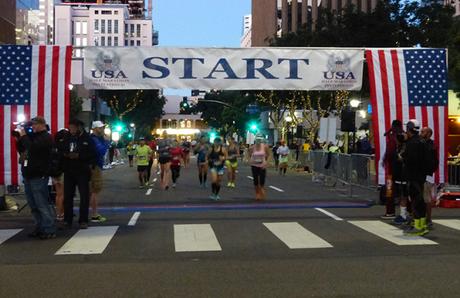
(Happy birthday, Nico! At 8 years old you probably don’t spend a lot of time reading your uncle’s blog, so maybe just maybe your mom will pass this wish along to you…)
I’d put the question – long burning in my brain – to Boston Marathon Race Director Dave McGillivray during a group run at the annual Running USA conference back in February. Had he ever considered a Boston-type, qualifiers-only race for the half marathon distance? “Funny you should mention that…” was his reply as we ran through the French Quarter in New Orleans, weaving around street cleaners and sidestepping discarded memories of the previous night.
As he’d outlined the template for just such an event, coming to San Diego in November, I’d mentally added it to my late-season schedule. Race management would be handled by Ken Nwadike Jr & his team at SoCal’s own Superhero Events (producers of the Hollywood Half and the Awesome ‘80s Run) as well as Merhawi Keflegizhi, founder & owner of HAWI Management (and who I’m sure never tires of being referred to as “Meb’s brother”). Dave’s own DMSE Sports, meanwhile, would be in charge of the road cones, zip ties and duct tape, as Dave himself likes to say.
Having run my first half marathon in 2001 and 39 more since, I’d been awaiting and looking forward to a race like the USA Half for a long time – a raison d’être for competitive 13.1-ers who (until now) have had no premier event to motivate them as their marathoning counterparts have for 120 years. Even 19 marathons and two 50Ks into my running career, the half marathon still appeals to me as the perfect blend of speed and stamina.
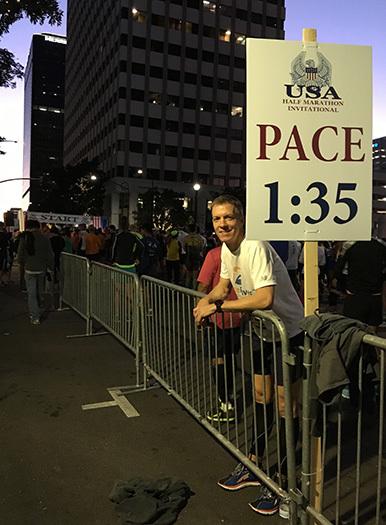
Holding a steady 1:35 pace in the start corral
Now at last here I was, keeping the 1:35 pace sign company as the dawn’s early light replaced the electric glow of downtown San Diego. Katie stood smiling outside the start corral with camera poised, ready to assume her unofficial role of race photographer before the a cappella singing of the national anthem had even concluded. She wore jeans and a light fleece, while I sported my usual race-day attire of RaceRaves tee and shorts. Nothing unusual about our choice of apparel – except that we were both perfectly comfortable wearing it.
That’s rarely the case – I prefer to reach the start line shivering, knowing that once the starter’s pistol fires and I cross that line, the pendulum will swing and I’ll warm up in a hurry. After all, heat production by muscles can soar 15 to 20 times above resting levels during vigorous exercise. So cooler temperatures benefit the runner, by reducing the amount of heat lost during the conversion of chemical energy to mechanical energy.
This inefficient conversion and the resulting heat loss is, in fact, a major reason the two-hour marathon barrier remains solidly intact.
Spectating, of course, tends not to be vigorous exercise, and so the cooler temperatures that benefit runners prompt most spectators to layer up like race-day mummies. Meaning it’s highly unusual for both runners and spectators to find themselves faced with favorable conditions on race day, especially at the start. Of course, it’s also unusual for race-day temps on Nov 21 to start at 55°F and rise from there.
Welcome to America’s Finest City – the land that seasons forgot.
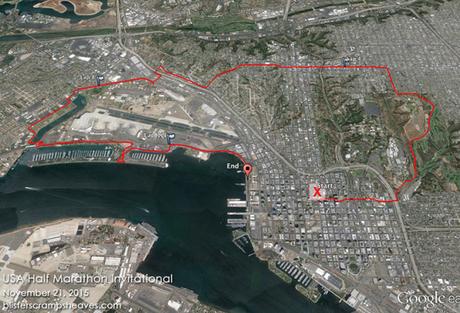
As the airhorn sounded and 2,400+ runners streamed under the start banner flanked by U.S. flags, I felt a surprising calm – the offspring of temperate weather and tempered expectations. Shockingly, the Inaugural USA Half would be my first race in six months (and my first in the 45-49 age group), an unheard-of respite in recent years and my longest break between races since 2008.
But I hadn’t been resting on the laurels of my Boston Qualifier at May’s Mountains 2 Beach Marathon (see what I did there?). My absence from the race circuit owed itself to a whirlwind six months spent immersed in work and – the real wild card – purchasing & remodeling a townhouse on the west side of L.A. Managing the latter for three months came to feel like a part-time job/full-time babysitting gig, if babysitting required putting your signature to dozens of government forms. I could even liken a leaky skylight to a soiled diaper… but I won’t.
My euphoric legs carried me smoothly with the flow of foot traffic east along the first ¾-mile straightaway. Like concrete waves mimicking the roll of the ocean behind us, the undulating blocks of B Street prepared our legs for tougher climbs to come. As we passed under Highway 5 and turned north up the first of these climbs, a gentle ocean breeze greeted us as if to say, “Hope this helps – I’m as cold as it gets!” My mind flashed to my mom and sister facing near-freezing temperatures in Dallas, and to my friend Pete’s admission that Chicago had been expecting 3-5 inches of snow the night before.
I’d glanced at the course map the day before and noted the route’s Jekyll & Hyde nature: hilly in the first half, Kansas-flat in the second. But seeing hills on a map is one thing – knowing how they’ll affect your race is another. Barring extremes like a Pikes Peak, it’s tough to assess “hilly” until you’re feeling it in your quads and lungs.
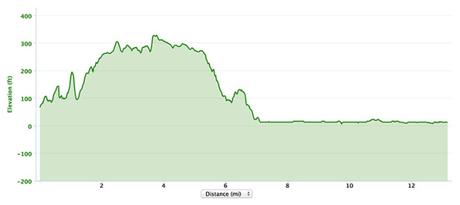
Living in CA, this strikes me as more “seismogram” than “race elevation profile”
With that in mind, my race strategy was its usual simplicity: run fast. As fast as possible without crashing & burning and ending up a charred mass of muscles, tendons & ligaments by mile 11. This less-than-scientific approach felt reasonable given the recent regression in my training volume, which I’d managed to maintain at 40-45 miles/week, though with very little speed work.
So with a PR of 1:34:02 (Oakland 2012), I figured I’d arrogantly start with the fast kids in the 1:35 pace zone, then hold that pace for as long as possible. If I bonked, I bonked – but if not, then I wanted to see what my legs were capable of after six months of relative rest (compared to my training regimen for Mountains 2 Beach). Problem was, with official pacers running at 1:30 (too fast) and 1:40 (too slow), 1:35 left me running in no man’s land. And I’d be running there entirely by feel, having promised myself I’d use my Garmin only to log my splits for later.
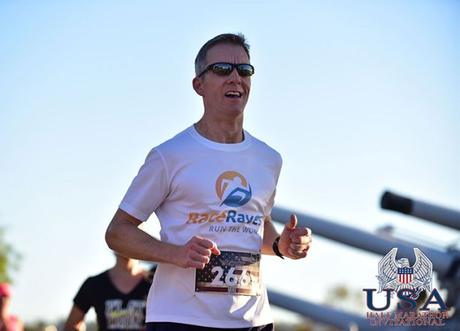
(Free race photo courtesy of Runner Buzz Media)
Cresting the first ¼-mile ascent, the road immediately turned back downhill as it would several more times over the next six miles. To be fair, what this course taketh it would also giveth back – for each ascent conquered, runners could look forward to a corresponding descent, and my Garmin actually calculated a net loss of ~50 feet over the course of 13.1 miles.
Not that the hilltops provided much in the way of scenic vistas. The first 10 miles of the course wound its way in a counterclockwise loop around the city – nondescript neighborhoods and strip malls dominated the urban landscape, along with the occasional highway over- & underpasses. The most scenic stretch of the first 10 miles was (with apologies to Stephen King) the green mile flanking Balboa Park in mile 3.
But I hadn’t come to San Diego to work on my tan, do some casual sightseeing and collect a medal at the end of it. I was here chasing the same uncomplicated goal as others around me – to get from start to finish as quickly as possible. Unlike other races I saw no walkers along the course, no costumes, no BRFs strolling side-by-side in conversation (though a few remarkable runners were maintaining a brisk pace while pushing a stroller or wheelchair, a la Boston legends Dick Hoyt and his son Rick).
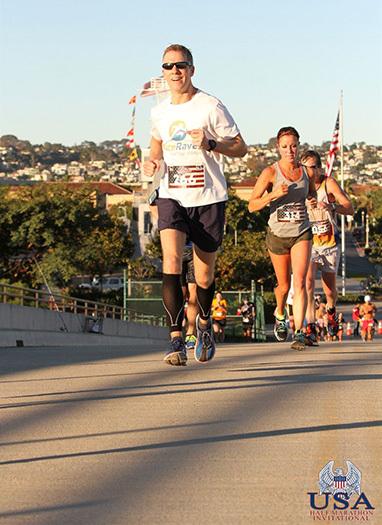
Ascending the Halsey Road Bridge in mile 10 (free race photo courtesy of Runner Buzz Media)
This emphasis on competitive racing is echoed by the USA Half website:
With so many fun runs, mud runs, and color runs being launched nationwide, we noticed a decline in the production of competitive endurance events in the United States. This race was developed to encourage recreational runners to set new goals and challenges for themselves. The USA Half Marathon is the first ‘Qualifiers Only’ half marathon, designed for elite, sub-elite, and competitive runners.
I should interject here to say There’s nothing wrong with the casual runner, the diversity of its participants is what makes our sport great. At the same time, life is all about new goals and challenges, and there are plenty of races that already cater to the casual runner – among them San Diego’s own flagship Rock ‘n’ Roll event in June. So I’m psyched to have an event that targets those of us who actually want to run until we keel over.
In fact, we’d liked the idea so much that we’d independently introduced the event to the running community on RaceRaves back in May, beating Runner’s World to the punch – though that hadn’t prevented them from, ahem, “borrowing” our article title.
Now, 6½ months later, I was here to find out what all our fuss was about.
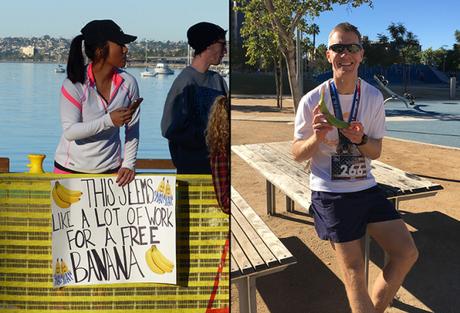
In my defense, the free bananas were all-you-can-eat
True to the event’s competitive ethic, musical entertainment along the course was limited to one fellow with his boombox blasting, its distorted speakers clearly taxed beyond their limits. Understandably for 6:00am on a Saturday, spectators were few and far between. Two women blew into vuvuzelas as we passed, each generating a low & uninspiring wail that sounded more like a grieving sea lion than anything motivational.
And on we ran.
At mile six I glanced up to see Katie cheering alongside the mile marker ahead, always a pick-me-up and especially since I hadn’t been sure if/when she’d make it out on the course. Just past her I leaned into the next right turn, heading up the waiting ascent toward Highway 5.
Though I didn’t realize it at the time, somewhere along this otherwise unremarkable stretch occurred the lowlight of my race. Apparently 2009 New York City Marathon and 2014 Boston Marathon champ Meb Keflezighi was standing near the halfway mark, offering high-fives and cheering on the runners – and yet somehow I MISSED HIM. My best guess is that he didn’t arrive until later, because even as focused as I was and as unassuming as he is, it doesn’t compute that I would’ve passed Meb without noticing him. San Diego is Meb’s hometown – I figured he may be out on the course, particularly with his brother managing the event, and yet I missed him? I was and remain pretty bitter at the possibility. Next year I’ll be running with my head on a swivel, just in case.
It didn’t make me feel any better that Katie missed him, too.
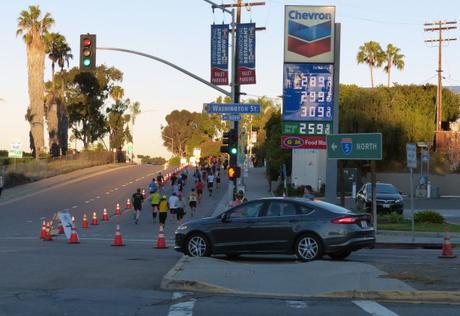
The start of mile 7, a.k.a. The missed-Meb mile
Ironically, that same mile would be my fastest of the day at 6:59. But by the time I’d crested the last of the rolling hills at the halfway mark, their collective message had been heard loud and clear: there would be no PR on this day. But that didn’t mean I’d be slowing down – instead, the last six miles would be the perfect opportunity to see just how much I had left. After all, I hadn’t come here expecting a PR, and it wasn’t like I had any better plans for the next 45 minutes.
And so it went – miles 8-10 ticked off uneventfully at 7:14, 7:09, 7:13. Mile 10 offered a reprieve from the concrete with a brief stretch of dirt path leading to the Halsey Road Bridge. Then it was on to N Harbor Dr for the final 3+ miles, the harbor to our right sparkling in the morning sun as if filled with the orphaned diamonds of sunken pirate ships.
The fact that miles 11-13 bordered the harbor and marina was good news; the bad news was that they also bordered the San Diego International Airport. Since N Harbor Dr is the access road for all airport arrivals and departures, this necessitated a one-mile hairpin detour down Island Harbor Dr toward the water, to avoid crossing (and thereby impeding) the flow of traffic to and from the airport. Like the hills before it, this detour inevitably slowed our pace as we negotiated two U-turns and headed back toward N Harbor Dr. The acrid waft of shuttle bus fuel reached my nostrils, then dispersed on the breeze as quickly as it had arrived.
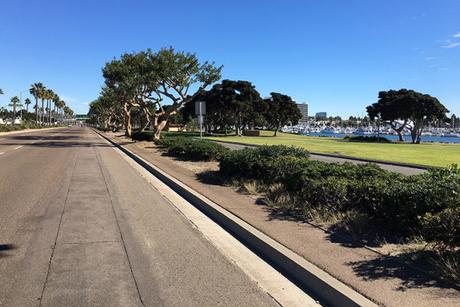
Mile 10 along North Harbor Drive, with the harbor to our right
The mile 12 marker greeted us as we exited the airport grounds. Straight into the rising sun we ran, hugging the shoreline, the brilliant blue sky presaging another postcard-perfect day. But aside from the roar of planes taking off, I could’ve run through Middle Earth in that last mile and not known the difference. I was focused only on the ground ten feet ahead of me, my feet chewing up pavement and my mind in the “No man (or woman) shall pass” zone. Yes, I was fatiguing… but “half marathon tired” is a much different beast than “marathon tired”. Rounding the marina I shifted gears one last time, accelerating toward the finish banner flanked – like its start line counterpart – by American flags.
One last Katie sighting to my left, one last surge to nose past one last runner, and I crossed the finish line of the first-ever USA Half Marathon in 1:35:26, my second-best half marathon time in 40 tries. The flatness of the final six miles had enabled a decisive negative split (48:16 first half, 47:10 second half), and my legs had risen to the challenge.

Immediately I was handed a bottle of water and then took my time shuffling through the finish chute, basking in the combined warmth of sunshine and accomplishment. Race Director Ken Nwadike Jr and his wife Sabrina stood just beyond the finish line, video camera poised to capture the emotions of spent finishers (see footage on the race website). Ken was everywhere on this day, even out on the course where Katie had seen him rolling along in the driver’s seat of his convertible, top down and camera trained on his runners.
Likewise, fellow organizer Hawi Keflezighi milled around the finish chute, patting finishers on the back and thanking them for coming. I introduced myself, shook his hand, and he recognized the RaceRaves name on my t-shirt. He and Ken (who we’d met at the pre-race expo and would meet again after the race) both struck me as personable and appreciative, another reason I hope to see this event thrive going forward.
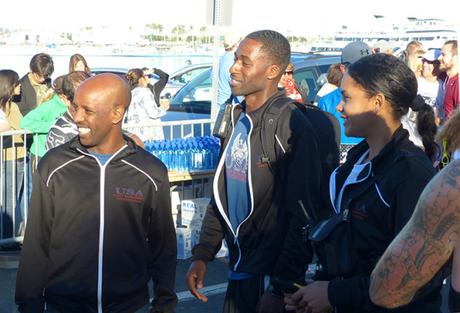
Race organizers (L-to-R) Hawi Keflezighi, Ken Nwadike Jr & Sabrina Nwadike
As mentioned we’d introduced the running community to the USA Half on RaceRaves back in May, calling the event “The Boston of Half Marathons” in reference to its competitive qualifying standards. This apparently blasphemous title prompted hair-trigger responses from those who felt the Boston Marathon needed its honor defended, with strident protests that lauded Boston’s long and storied history along with its tighter qualifying standards. So to those of you who get all your information from headlines – yes, we realize Boston has a 119-year head start on the USA Half, with all the tradition and community support that entails. And yes, we understand you can’t slap a “Boston Lite” label on an event and hope to build a venerated institution like Boston overnight – it is after all the pinnacle of its sport and the world’s oldest annual marathon.
That said, with an elite group of organizers (including the Boston RD himself) and a message that resonates with runners, the USA Half has the potential to become to half marathoners what Boston has long been to marathoners – a competitive dangling carrot to inspire their training, and a prestigious event to call their own. Add to that San Diego in late autumn, and this event is off to a compelling start.
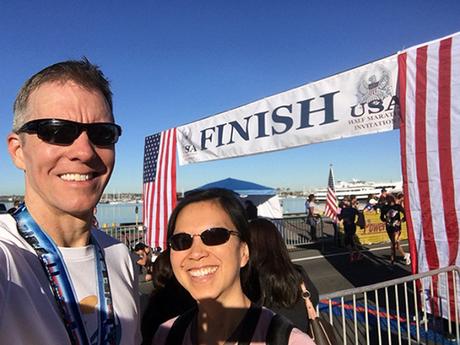
Red, white and through with the Inaugural USA Half
Admittedly, stricter qualifying standards will eventually go a long way toward building the race’s reputation and attracting the most competitive runners. Case in point, my own qualifying standard for this year’s Competitive (Open) Division was 2:05, a time I easily beat while wearing Hulk fists at last year’s Avengers Super Heroes Half Marathon. So maybe ([your Boston Qualifying standard ÷ 2] – 2.5 minutes) as a starting point for the non-elite Open Division? That would put the speediest qualifying standard at 1:30 (for men ages 18-34) and mine at 1:40, both of which feel like reasonable guesstimates.
Reflecting on the weathered naval vessels docked a stone’s throw away in the harbor, I glanced over to see the last vestiges of the dismantled finish line being loaded aboard a waiting truck – apparently the race’s 2:30 time limit was no joke. And it struck me that, after a near-PR effort on a hilly course, the USA Half would be the perfect high note on which to end my 2015 racing season.
But where’s the fun in perfect…?
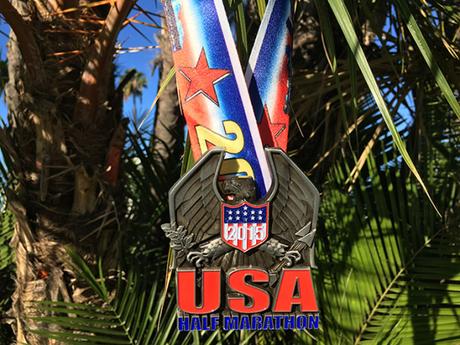
RaceRaves rating:
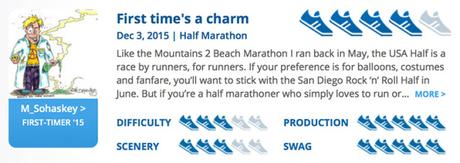
BOTTOM LINE: Like the Mountains 2 Beach Marathon I ran back in May, the USA Half is a race by runners, for runners. If your preference is for balloons, costumes and fanfare, you’ll want to stick with the San Diego Rock ‘n’ Roll Half in June. But if you’re a half marathoner who simply loves to run or who’s looking for a new type of challenge to motivate your training, then do yourself a favor and check out the USA Half. Its “qualifiers only” status and San Diego venue also make it a great option for 50 Staters looking for a distinctive California race.
The course is solidly urban and isn’t necessarily PR-friendly, with the first half falling somewhere between “rolling” and “hilly”. But the second half makes up for the sins of the first, with a Kansas-flat profile and a final three miles that border the sun-drenched harbor and marina. At $95.00 + processing fees the race isn’t cheap, but it’s a solid value – in both production and swag, you get what you pay for (see below).
The overarching patriotism of the event – from the name to the logo to the U.S. flags flanking both the start and finish lines – was a curious choice that wasn’t fully explored. I assume the star-spangled theme was in homage to the host city, which boasts a proud military (and specifically naval) history. In fact, several retired battleships – chief among them the USS Midway – now call the Port of San Diego their permanent home.
Given its overt patriotism and proximity to Veterans Day, it seems appropriate that next year’s race include a tribute to current military personnel, veterans and fallen heroes. And why not partner with a charitable organization that supports veterans? Because honestly, given that nearly $8 of every registration fee already goes to the hot mess that is Active.com, I certainly wouldn’t protest if a portion of my registration went to a worthy cause like veterans programs. This would also help engage the community and increase civic support for the race.
Overall, count me in for next year!
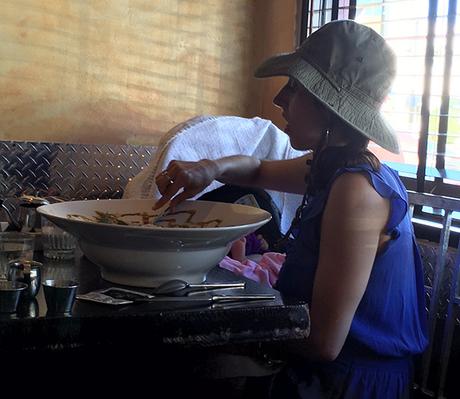
You won’t leave the Hash House A Go Go hungry – her salad bowl was as big as her infant child’s carrier
PRODUCTION: As expected given the parties in charge, event production was spot-on and a high point of the race. The pre-race expo (what we saw of it, arriving as we did an hour before it ended thanks to SoCal traffic) was small and easily navigated. Race day itself went off without a hitch, from the firing of the starter’s pistol at 6:00am sharp to the immediate and efficient disassembly of the finish line at 8:30am. The course was impeccably marked, to the point that my Garmin chimed the mile just as I hit the timing mat at mile 10. If GPS units can dream, then mine at that moment dreamed of being the official timer.
Aid stations (none of which I used, as usual) looked to be fully stocked, with vigilant volunteers calling out “Gatorade!” or “water!” as runners approached. As seems to be the case wherever I run, volunteers were friendly, encouraging and eager to help. Post-race snacks were plentiful, though finish-line festivities were minimal given the event’s constricted time limit of two-and-a-half hours (mandated by the city, I assume). And Ken made great use of his omnipresent camera, providing free race photos – always a much-appreciated bonus – courtesy of his own Runner Buzz Media.
SWAG: The race swag is a definite selling point, and includes a colorfully patriotic “USA” medal emblazoned with a bald eagle, as well as a black-with-white-zipper USA Half Marathon finishers jacket (though the logo on front could stand to be a bit brighter and more readable). Curiously, the jacket zipper is designed for left-handers. In any case, the jacket is a significant and much-appreciated upgrade from the standard race tech tee. And the medal will definitely stand out from its less flamboyant brethren.
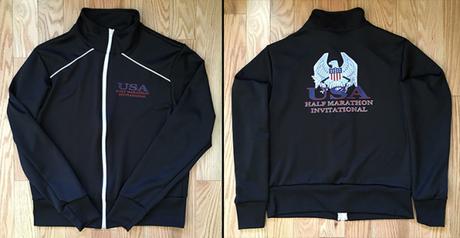
FINAL STATS:
November 21, 2015
13.16 miles in San Diego, CA
Finish time & pace: 1:35:26 (first time running the Inaugural USA Half Marathon), 7:15/mile
Finish place: 254 overall, 28/174 in M(45-49) age group
Number of finishers: 2,439 (1,121 men, 1,318 women)
Race weather: cool & sunny at the start (temp 55°F), warm & sunny at the finish
Elevation change (Garmin Connect): 456ft ascent, 509ft descent
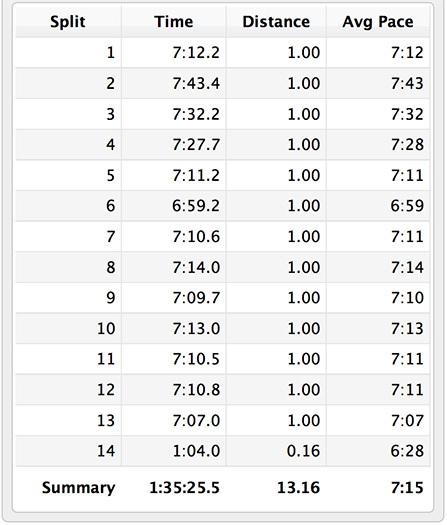
I’m feeling very positive about my negative splits
